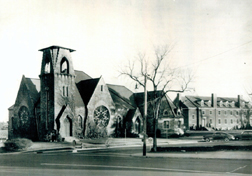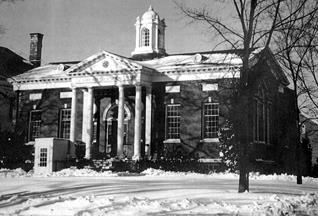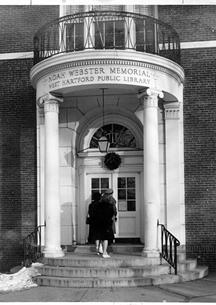
WHPL’s Origins
West Hartford has long been a “reading” community. In the 18th century, a subscription library was organized by members of the Congregational Church and in 1837, Noah Webster donated 78 books. From this gift evolved the West Hartford Library Association. Several years later, a group of enthusiastic readers in the south end of town formed the Elmwood Literary Association.
In 1897, the Town officially established the West Hartford Public Library with annual town funding of $250. The library continued to be housed at the First Church of Christ, Congregational. During the next two decades, the collection more than doubled in size and a significant increase in library use caused members of the community to call for a new and separate library building. A fund-raising campaign led by the Sarah Whitman Hooker Chapter of the Daughters of the American Revolution successfully raised $40,000. School children from all over town were happy to contribute their pennies in support of the planned Children’s Room.
The new library building, named to honor Noah Webster, was dedicated in February, 1917 during an elaborate public ceremony.

WHPL North Main Street—1930s
One indication of how much residents used and appreciated the library was the fact that the beautiful new building on North Main Street had been outgrown by the early years of the Great Depression. An extensive article in the Hartford Times in 1930 likened the library to the “Delphic Oracle” and listed such important services as reference, a picture collection, school reading list books, school classroom collections, story hours, teacher resources, and library instruction. Library reports indicate that the building was also used for meetings by local clubs and organizations including the Town Council. By 1937, planning had begun for a new library building at 20 South Main Street which was completed and dedicated in March of 1938.

South Main Street—1950s
The huge increase in West Hartford’s population during the 1950’s and 1960’s necessitated the expansion of the library system yet again. In 1954, the Elmwood Branch moved into its new home, named in honor of Elmwood librarian, Julia Faxon.
A major renovation and addition to the main library was completed in 1962. At the same time, planning began for a new branch facility at the north end of town. The Bishops Corner Branch was opened in 1966 to better serve residents in that rapidly developing area. Finally during this period, the scope of the library collection broadened to include recorded music and movies for use by schools and local groups. Reference and outreach services to schools, community organizations, homebound residents and nursing homes were expanded.
In the early 1980s, a new entrance on South Main Street was added to the Noah Webster Library, the entrance from the parking lot behind the building was renovated, an accessible elevator was installed, and the interior of the building was reconfigured.
Advances in technology and the advent of computers in the 1980’s had a dramatic effect on library service and collections. The familiar card catalog disappeared and the demand for audio-visual material in a variety of formats, computers for public use and expanded reference service required changes in procedures, programs and staffing. An increasingly diverse population called for a wider variety of materials and services. Growth and development in collections and services continue to this day, requiring staff to be innovative and flexible.
On Jan. 6, 2008, the Noah Webster Library reopened after a major renovation which blended old and new in a brighter, more spacious faciility that includes a new public computer lab, dedicated areas for the local history and world languages collections, enhanced teen and children’s spaces, and comfortable public meeting rooms. A similar renovation project is was completed at the Bishop’s Corner Library in October, 2012.
Our town, once a tiny farming community, has changed beyond measure since the days of the subscription library in the Congregational Church, and the world of libraries and information service bears only a superficial resemblance to that tiny collection of books donated by Noah Webster. Throughout all the years of change, however, one thing has remained constant. West Hartford, a community of “readers,” has continued to use and support the West Hartford Public Library as it has reinvented itself to meet the expanding needs of all local residents.
